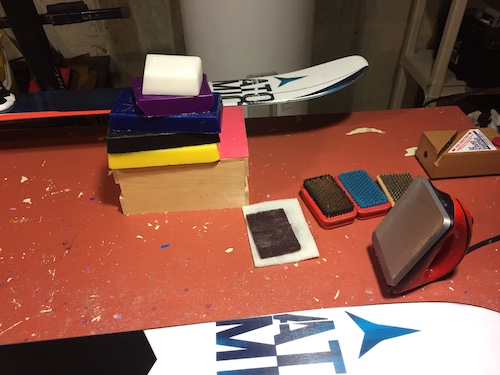DIY or not DIY: that is the question.
If you’re like a lot of people, you bring your skis to your local shop and let someone else handle it for you. The tools and techniques of ski tuning can seem intimidating, especially if learning new manual skills feels a bit outside your comfort zone. For women especially, repair and maintenance skills can be a mystery. Often they’re not passed on to us because of an assumption that we won’t need them or have any interest.
But three years ago I decided to try waxing my own skis, and I’ve never looked back. Now I take care of most aspects of tuning myself, and I actually look forward to the process and have discovered a number of unexpected benefits along the way.
Why do it yourself?
Well, for one thing, you’ll save a lot of money. At up to $50 for a full tune including edge sharpening and a base grind, the cost of having someone else take care of your skis can add up. For an investment of under a hundred dollars, you can set yourself up to keep your bases and edges in great shape and minimize the time they spend in the shop. Your skis will also perform better with more regular attention.
But there’s more to it than just economics. The simple act of learning to wax my own skis brought me unexpected pleasure. The work itself was easy enough to do while listening to music or a podcast, and it was surprisingly satisfying; it feels good to achieve competence at something new. And I started noticing things about my skis; feeling along the edges, I could detect burrs and nicks, dull spots, and rust. On the base I could see dry areas and narrow scrapes and sometimes deep gouges. I felt certain that I could tackle these issues, too. And sure enough, learning to deburr edges and use p-tex to repair base damage was easy and fun.
Can you do it, too?
Absolutely. In in this era of YouTube instructional videos and specialized discussion forums, it’s easier than ever to acquire mastery in areas well outside our comfort zone. All you’ll need to get started are a few basic tools and enough work space.
Before waxing, take a good look at your side edges. Is there any rust? A few passes with a gummi stone will erase that. And drying your skis off after use will also prevent rust from developing in the first place. If you feel any irregularities as you pass a finger lightly over your edges, take an edge trick or an aluminum oxide stone and pass it along the edge with medium pressure. Follow that with a light pass of the gummi stone and you’re all set.

A basic waxing setup: Iron, brushes, and Scotch-Brite pads. A plastic scraper is also needed.
To wax your bases, start with an inexpensive kit that contains a waxing iron, a scraper, and some all-temperature wax. (Don’t use a clothing iron; the temperature is hard to regulate and you run the risk of burning the wax and/or your bases). You’ll need a sturdy rubber band to hold the brakes back and something to set the skis on. I use a Wintersteiger vise that was reasonably priced and ended up being pretty reliable. You could use sawhorses, books, or a couple of chairs, as well.
Set the iron for the temperature recommended on the wax label and drip wax along the length of the ski, making sure that the iron is not smoking. Then simply move the iron back and forth along the base of the ski until the wax is melted. Always keep the iron moving. Let the wax cool for at least an hour, but preferably several hours, and then scrape from tip to tail. You can then use a nylon brush to polish the bases and remove any remaining wax.
How often you wax your bases is up to you and the conditions under which you ski. I tend to do it after every six or seven days on snow here in the New England. Everyone develops their own technique and habits, and there are plenty of resources on YouTube and other places. You can get into temperature-specific wax and additional tools for more specific work, for instance. And you may find that the confidence gained in the process translates to other areas, such as home and car repair. I definitely find myself much more open to the idea that I can tackle complex projects with enough patience, guidance, and practice.
And that confidence may be the biggest benefit of all.
Resources for Waxing and Tuning
Outside Online: “How Do I Wax My Skis at Home?”
MaineSkiFamily: “How to Sharpen Skis”
The Race Place: “How to Tune Ski Edges”
